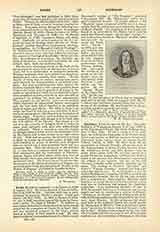

Llandaff, Ancient Diocese of (LANDAVENSIS). —The origins of this see are to be found in the sixth century monastic movement initiated by St. Dubricius, who presided over the monastery of Mochros. The saint made his disciple, St. Teilo, abbot of the daughter monastery of Llandaff, which after the retirement of Dubricius to Bardsey came to be the chief monastery. The abbots of Llandaff were in episcopal orders and SS. Teilo and Dubricius are referred to as archbishops. The territory in which Llandaff was situated belonged to the kings or chiefs of Morganwg or Gwent, who presented gifts of lands to the Church of Llandaff. The early title “archbishop” implied only rule over other monasteries, and as the episcopate became diocesan it gave way to the usual style of bishop. The successors of St. Teilo long maintained absolute independence within their own territories, and the rights and privileges of the Church of Llandaff were extensive. The early history of the see, the chief authority for which is the “Book of Llandaff” (Llyfr Teilo, Teilo’s book), is very obscure, and the order of the bishops uncertain. When St. Augustine began the conversion of the Saxons in 597 he invited the British bishops to cooperate, but they refused and there was no communication between the Celtic clergy and the Roman missionaries. Unfortunately this resulted in long enmity between the Churches in Wales and in England. It was not till 768 that the Welsh clergy adopted the Roman use of Easter. From this time Welsh bishops and kings went on frequent pilgrimage to Rome, and relations with the Saxon episcopate became more friendly. After the Conquest the archbishops of Canterbury exercised their jurisdiction over Wales, and St. Ansehn placed Bishop Herwald of Llandaff under interdict. Herwald’s successor Urban was consecrated at Canterbury, after taking an oath of canonical obedience to the archbishop, and from that time Llandaff became a suffragan of Canterbury. A standing difficulty was the admixture of race and language due to the English settlements, also to the ignorance and incontinence of the Welsh clergy, who had ceased to observe celibacy and gave scandal to the Normans and English. A reform was gradually effected, chiefly by the establishment of new monasteries. The Benedictines had houses at Chepstow, Abergavenny, Goldcliff, Bassaleg, Usk, Llangyran, Ewenny, and ardiff; the Cistercians, at Neath, Tintern, Margam, Grace Dieu, Caerleon, and Llantarnam; Cluniacs at Malpas; Premonstratensians at St. Kynemark; Dominicans, Franciscans, and Carmelites were settled in Cardiff.
The cathedral, begun in 1120, was enlarged at the close of the twelfth century. It was regarded as a fine specimen of Early English architecture, but after the Reformation was allowed to fall into a ruinous state, from which it was restored during the nineteenth century. In the following list of bishops of Llandaff, the order and dates of all before the tenth century are unknown. St. Dubricius (Dyfrig) is sometimes given as the first bishop, but more correctly the episcopal succession begins with St. Teilo, who was succeeded by Oudoceus. After him came Ubilwynus Aidanus, Elgistil; Lunapeius, Comegern, Argwistii, Gurvan, Guodlom, Edilbinus, Grecielus, all of doubtful authenticity. More historical are Berthguin Trychan, Elvog Catguaret, Edilbiu, Grecielis Cerenhir, Nobis, and dud. Cimeilliauc, Libiau, Marchluid, Pater, Gulfrit, Gucaun (consecrated in 982), Bledri (983), Joseph (1022), Herwald (1056) Urban (Worgan) (1107), vacancy (1134), Uchtryd (1140), Nicholas ap Gwrgant (1148), vacancy (1183), William Saltmarsh (1186), Henry of Abergavenny (1193), William of Goldcliff (1219), Elias de Radnor (1230), vacancy (1240), William de Burgh (1245), John de la Ware (1254), William de Radnor (1257), William de Braose (1266vacancy (1287) John of Monmouth (1296), John de Eglesclif (1323), John Pascal (1347), Roger Cradock (1361), Thomas Ruchook (1383), William Bottlesham (1386), Edmund Bromfield (1389), Tideman de Winchcomb (1393), Andrew Barrett (1395), John Burghill (1396), Thomas Peverell (1398), John de la Zouche (1408), John Wells (1425), Nicholas Ashby (1441), John Hunden (1458), John Smith (1476), John Marshall (1478), John Ingleby (1496), Miles Salley (1500), George de Athequa (1517), Robert Holgate (1537), Anthony Kitchin (1545), who alone of the English episcopate fell into schism under Elizabeth and died in 1563. The ancient diocese comprised the Counties of Glamorgan and Monmouth except a few parishes in each. It contained but one archdeaconry (Llandaff). The’ dedication of the cathedral was to SS. Peter, Andrew, Dubricius, Teilo, and Oudoceus, and the arms of the see were sable, two crosiers in saltire, or and argent, in a chief azure three mitres with labels of the second.
EDWIN BURTON

